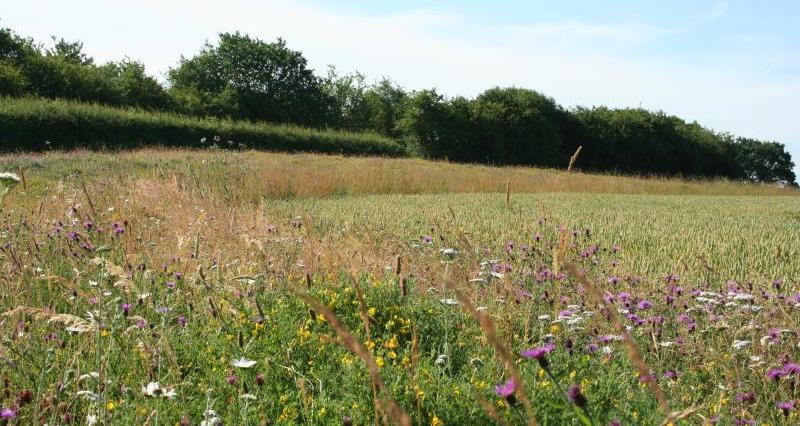What
Pollen and nectar mixes are an easy way to boost flower-rich habitats on farmland. Aim for at least 1% of arable land to be managed as flower-rich margins to support crop pollinators and other important insects.
Why
Pollen and nectar mixtures provide plants throughout spring and summer to supply food for insects such as butterflies and bumblebees.
Some insects, such as bumblebees, are vital pollinators of crops and wild flowers. Bumblebees have declined as suitable plants, such as red clover, have become scarcer in the countryside. These, and other insects, benefit from sowing flower-rich mixtures.
Hoverflies are especially attracted to flowering plants and will lay eggs wherever there is an abundance of aphids for their larvae to feed on, thus helping to reduce numbers of these pests in nearby crops. The general increase in insects attracted to these mixtures also provides food for birds.
How
- Create a network of habitats for insects around the farm (e.g. 6m margins).
- Use a mix of at least four nectar-rich plants, such as red clover, alsike clover and bird’s-foot-trefoil.
- Fine grasses, such as fescues, bents and meadow grasses, can be used in the mix to reduce the impact of annual weeds. A mix of 80% fine grasses and 20% legumes should be sown at a seed rate of 15-20 kg/ha.
- Choose locations that receive a lot of sunlight. These plots also look attractive, so consider siting them along footpaths.
- March/April or July/August are the best months for establishment. If there is a heavy weed burden, then spray with a herbicide such as glyphosate or glufosinate before cultivation.
- Apply no fertiliser or pesticides. Herbicide use is restricted to use of a contact non-residual herbicide prior to establishment, or spot treatment or weed-wiping of pernicious weeds. Treat any noxious weeds as soon as possible to avoid them becoming established.
- Take steps to prevent the drift of pesticides or fertilisers from the adjacent crops.
- Pollen and nectar mixtures may be sown on arable land or grassland. Do not create plots on unimproved or species-rich grassland. Grazing of the plots is only permitted in autumn and winter, but ensure the sward is not damaged by excessive cattle trampling.
- Half of the area should be cut in June to stimulate late flowering, and the whole area should be cut in September or October. Check the plot for leverets or nesting game birds before cutting in June. Ideally remove cuttings. Otherwise, try to finely chop and spread the cuttings to avoid smothering the sward.
- The mix may need to be re-established after three to four years if the flowering plant component has become depleted.
- Other means of providing flower-rich habitats on the farm include wildflower margins and rotational trimming of hedgerows to boost flowering hawthorn and blackthorn.
